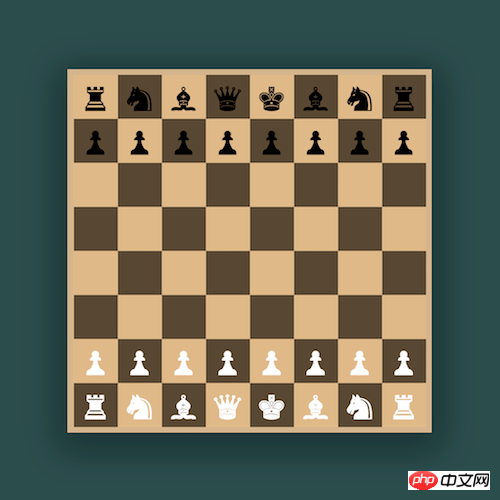How to implement a chess set using pure CSS
This article mainly introduces how to use pure CSS to implement a chess set, which has certain reference value. Now I share it with everyone. Friends in need can refer to it

Source code download
Please download all the source code of the daily front-end practical series from github:
https://github.com/comehope/front-end-daily-challenges
Code Interpretation
Define dom, a total of 8 lists, each list contains 8 elements:
<p class="chess">
<ul>
<li></li><li></li><li></li><li></li>
<li></li><li></li><li></li><li></li>
</ul>
<ul>
<li></li><li></li><li></li><li></li>
<li></li><li></li><li></li><li></li>
</ul>
<ul>
<li></li><li></li><li></li><li></li>
<li></li><li></li><li></li><li></li>
</ul>
<ul>
<li></li><li></li><li></li><li></li>
<li></li><li></li><li></li><li></li>
</ul>
<ul>
<li></li><li></li><li></li><li></li>
<li></li><li></li><li></li><li></li>
</ul>
<ul>
<li></li><li></li><li></li><li></li>
<li></li><li></li><li></li><li></li>
</ul>
<ul>
<li></li><li></li><li></li><li></li>
<li></li><li></li><li></li><li></li>
</ul>
<ul>
<li></li><li></li><li></li><li></li>
<li></li><li></li><li></li><li></li>
</ul>
</p>Centered display:
body {
margin: 0;
height: 100vh;
display: flex;
align-items: center;
justify-content: center;
background-color: darkslategray;
}Define the background of the container Color and size (size determined by font size):
.chess {
background-color: burlywood;
font-size: 32px;
}Draw a grid-shaped chessboard:
ul {
display: table;
margin: 0;
padding: 0;
}
li {
display: table-cell;
width: 1.5em;
height: 1.5em;
}Set the color of the grid:
ul:nth-child(odd) li:nth-child(even),
ul:nth-child(even) li:nth-child(odd) {
background-color: rgba(0, 0, 0, 0.6);
}Place the chess pieces on the board :
<p class="chess">
<ul>
<li>♜</li>
<li>♞</li>
<li>♝</li>
<li>♛</li>
<li>♚</li>
<li>♝</li>
<li>♞</li>
<li>♜</li>
</ul>
<ul>
<li>♟</li>
<li>♟</li>
<li>♟</li>
<li>♟</li>
<li>♟</li>
<li>♟</li>
<li>♟</li>
<li>♟</li>
</ul>
<ul>
<li></li><li></li><li></li><li></li>
<li></li><li></li><li></li><li></li>
</ul>
<ul>
<li></li><li></li><li></li><li></li>
<li></li><li></li><li></li><li></li>
</ul>
<ul>
<li></li><li></li><li></li><li></li>
<li></li><li></li><li></li><li></li>
</ul>
<ul>
<li></li><li></li><li></li><li></li>
<li></li><li></li><li></li><li></li>
</ul>
<ul>
<li>♟</li>
<li>♟</li>
<li>♟</li>
<li>♟</li>
<li>♟</li>
<li>♟</li>
<li>♟</li>
<li>♟</li>
</ul>
<ul>
<li>♜</li>
<li>♞</li>
<li>♝</li>
<li>♛</li>
<li>♚</li>
<li>♝</li>
<li>♞</li>
<li>♜</li>
</ul>
</p>Set the color of the chess pieces:
ul:nth-child(-n+2) {
color: black;
}
ul:nth-child(n+7) {
color: white;
}Finally, add a little three-dimensional effect to the chessboard:
.chess {
border: 0.2em solid tan;
box-shadow: 0 0.3em 2em 0.4em rgba(0, 0, 0, 0.3);
}You’re done!
The above is the entire content of this article. I hope it will be helpful to everyone's study. For more related content, please pay attention to the PHP Chinese website!
Related recommendations:
How to use pure CSS to achieve the effect of a color card
How to use pure CSS to achieve the effect of a cartoon parrot
The above is the detailed content of How to implement a chess set using pure CSS. For more information, please follow other related articles on the PHP Chinese website!

Hot AI Tools

Undresser.AI Undress
AI-powered app for creating realistic nude photos

AI Clothes Remover
Online AI tool for removing clothes from photos.

Undress AI Tool
Undress images for free

Clothoff.io
AI clothes remover

AI Hentai Generator
Generate AI Hentai for free.

Hot Article

Hot Tools

Notepad++7.3.1
Easy-to-use and free code editor

SublimeText3 Chinese version
Chinese version, very easy to use

Zend Studio 13.0.1
Powerful PHP integrated development environment

Dreamweaver CS6
Visual web development tools

SublimeText3 Mac version
God-level code editing software (SublimeText3)

Hot Topics
 Table Border in HTML
Sep 04, 2024 pm 04:49 PM
Table Border in HTML
Sep 04, 2024 pm 04:49 PM
Guide to Table Border in HTML. Here we discuss multiple ways for defining table-border with examples of the Table Border in HTML.
 Nested Table in HTML
Sep 04, 2024 pm 04:49 PM
Nested Table in HTML
Sep 04, 2024 pm 04:49 PM
This is a guide to Nested Table in HTML. Here we discuss how to create a table within the table along with the respective examples.
 HTML margin-left
Sep 04, 2024 pm 04:48 PM
HTML margin-left
Sep 04, 2024 pm 04:48 PM
Guide to HTML margin-left. Here we discuss a brief overview on HTML margin-left and its Examples along with its Code Implementation.
 HTML Table Layout
Sep 04, 2024 pm 04:54 PM
HTML Table Layout
Sep 04, 2024 pm 04:54 PM
Guide to HTML Table Layout. Here we discuss the Values of HTML Table Layout along with the examples and outputs n detail.
 Moving Text in HTML
Sep 04, 2024 pm 04:45 PM
Moving Text in HTML
Sep 04, 2024 pm 04:45 PM
Guide to Moving Text in HTML. Here we discuss an introduction, how marquee tag work with syntax and examples to implement.
 HTML Ordered List
Sep 04, 2024 pm 04:43 PM
HTML Ordered List
Sep 04, 2024 pm 04:43 PM
Guide to the HTML Ordered List. Here we also discuss introduction of HTML Ordered list and types along with their example respectively
 HTML onclick Button
Sep 04, 2024 pm 04:49 PM
HTML onclick Button
Sep 04, 2024 pm 04:49 PM
Guide to HTML onclick Button. Here we discuss their introduction, working, examples and onclick Event in various events respectively.
 HTML Input Placeholder
Sep 04, 2024 pm 04:54 PM
HTML Input Placeholder
Sep 04, 2024 pm 04:54 PM
Guide to HTML Input Placeholder. Here we discuss the Examples of HTML Input Placeholder along with the codes and outputs.






